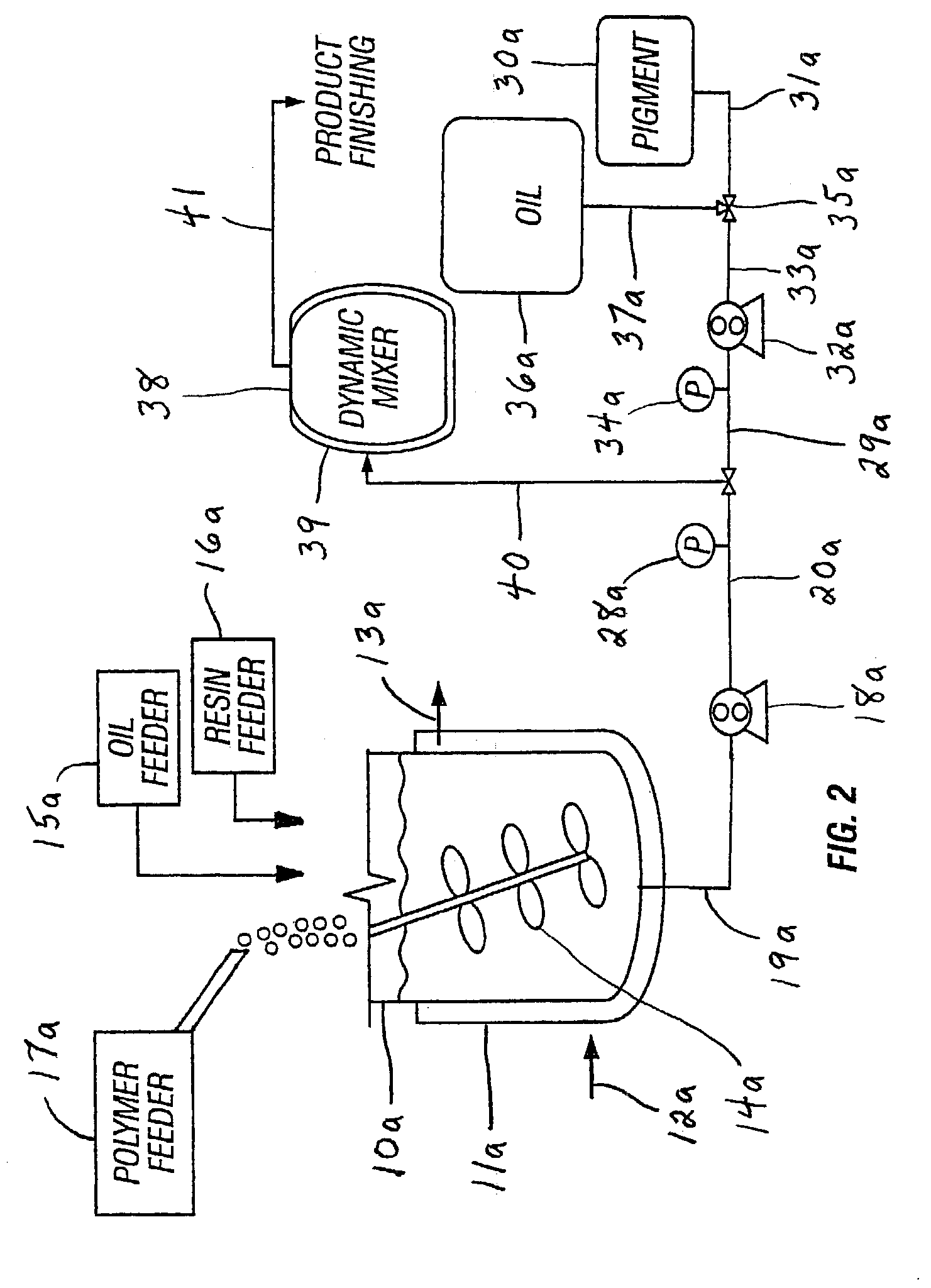Method of post mixing additives to hot melt adhesives
- Summary
- Abstract
- Description
- Claims
- Application Information
AI Technical Summary
Benefits of technology
Problems solved by technology
Method used
Image
Examples
example 1
1) White EVA Based Hot Melts Made Using a Static Mixer.
[0066]An EVA based hot melt adhesive was produced in a turbine kettle using typical process conditions. The composition was comprised of 39% of aromatic modified aliphatic hydrocarbon resin, 59% of ethylene / vinyl acetate copolymer and 0.5% of antioxidant. The product was mixed at 325° F. Once the batch was done, the pigment and adhesive gear pumps were calibrated to obtain consistent flow that would give 1.5% pigment level. The static mixer (SMX diameter 1.5 inches and length 18 inches containing 12 elements) was kept at 325° F. Adhesive was allowed to flow through a gear pump to the static mixer. When adhesive was coming out of the static mixer, the pigment gear pump was started. The pigment was added in the form of a dispersion in mineral oil. A couple of pounds were necessary to obtain a homogenous color. Before the end of the batch, the pigment pump was shut down and oil was introduced in the pigment addition tube to purge t...
example 2
2) Blue SBS Block Copolymer Based Hot Melt Made Using a Static Mixer.
[0069]An SBS based hot melt adhesive was produced in a turbine kettle using typical process conditions. The composition was comprised of 19.3% of white mineral oil, 59.2% of styrenated polyterpene hydrocarbon resin, 19.7% of styrene / butadiene / styrene multi-block copolymer and 0.7% of antioxidant. The product was mixed at 325° F. and then reduced to 260° F. Once the batch was done, the pigment and adhesive gear pump were calibrated to obtain consistent flow that would give 1.1% pigment level. The static mixer (SMX diameter 1.5 inches and length 18 inches containing 12 elements) was kept at 260° F. Adhesive was allowed to flow through a gear pump to the static mixer. When adhesive was coming out of the static mixer, the pigment gear pump was started. The pigment was added in the form of a dispersion in mineral oil. A couple of pounds were necessary to obtain a homogenous color. Before the end of the batch, the pigmen...
example 3
3) Green SBS Block Copolymer Based Hot Melts Made Using a Static Mixer.
[0071]An SBS based hot melt adhesive was produced in a turbine kettle using typical process conditions. The composition was comprised of 15.2% of white mineral oil, 58% of styrenated polyterpene hydrocarbon resin, 19.7% of styrene / butadiene / styrene multi-block copolymer and 0.7% of antioxidant. The product was mixed at 325° F. and then reduced to 265° F. Once the batch was done, the pigment and adhesive gear pump were calibrated to obtain consistent flow that would give 6.4% pigment level. The static mixer (SMX diameter 1.5 inches and length 18 inches containing 12 elements) was kept at 265° F. Adhesive was allowed to flow through a gear pump to the static mixer. When adhesive was coming out of the static mixer, the pigment gear pump was started. The pigment was added in the form of a dispersion in mineral oil. A couple of pounds were necessary to obtain a homogenous color. Before the end of the batch, the pigmen...
PUM
| Property | Measurement | Unit |
|---|---|---|
| Fraction | aaaaa | aaaaa |
| Fraction | aaaaa | aaaaa |
| Fraction | aaaaa | aaaaa |
Abstract
Description
Claims
Application Information
 Login to View More
Login to View More - R&D
- Intellectual Property
- Life Sciences
- Materials
- Tech Scout
- Unparalleled Data Quality
- Higher Quality Content
- 60% Fewer Hallucinations
Browse by: Latest US Patents, China's latest patents, Technical Efficacy Thesaurus, Application Domain, Technology Topic, Popular Technical Reports.
© 2025 PatSnap. All rights reserved.Legal|Privacy policy|Modern Slavery Act Transparency Statement|Sitemap|About US| Contact US: help@patsnap.com



